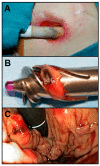Cardiac Assist Devices: Early Concepts, Current Technologies, and Future Innovations
- PMID: 30781387
- PMCID: PMC6466092
- DOI: 10.3390/bioengineering6010018
Cardiac Assist Devices: Early Concepts, Current Technologies, and Future Innovations
Abstract
Congestive heart failure (CHF) is a debilitating condition that afflicts tens of millions of people worldwide and is responsible for more deaths each year than all cancers combined. Because donor hearts for transplantation are in short supply, a safe and durable means of mechanical circulatory support could extend the lives and reduce the suffering of millions. But while the profusion of blood pumps available to clinicians in 2019 tend to work extremely well in the short term (hours to weeks/months), every long-term cardiac assist device on the market today is limited by the same two problems: infections caused by percutaneous drivelines and thrombotic events associated with the use of blood-contacting surfaces. A fundamental change in device design is needed to address both these problems and ultimately make a device that can support the heart indefinitely. Toward that end, several groups are currently developing devices without blood-contacting surfaces and/or extracorporeal power sources with the aim of providing a safe, tether-free means to support the failing heart over extended periods of time.
Keywords: LVAD; cardiac assist devices; congestive heart failure; destination therapy.
Conflict of interest statement
The authors declare no conflict of interest.
Figures








Similar articles
-
Muscle-Powered Counterpulsation for Untethered, Non-Blood-Contacting Cardiac Support: A Path to Destination Therapy.IEEE Trans Biomed Eng. 2020 Nov;67(11):3035-3047. doi: 10.1109/TBME.2020.2974826. Epub 2020 Feb 18. IEEE Trans Biomed Eng. 2020. PMID: 32086191 Free PMC article.
-
Total artificial hearts: bridge to transplantation.Cardiol Clin. 2003 Feb;21(1):101-13. doi: 10.1016/s0733-8651(02)00136-4. Cardiol Clin. 2003. PMID: 12790049 Review.
-
Current Role of the Total Artificial Heart in the Management of Advanced Heart Failure.Curr Cardiol Rep. 2019 Nov 22;21(11):142. doi: 10.1007/s11886-019-1242-5. Curr Cardiol Rep. 2019. PMID: 31758343 Review.
-
Cardiac extracorporeal life support: state of the art in 2007.Cardiol Young. 2007 Sep;17 Suppl 2:104-15. doi: 10.1017/S1047951107001217. Cardiol Young. 2007. PMID: 18039404 Review.
-
Circulatory support with pneumatic paracorporeal ventricular assist device in infants and children.Ann Thorac Surg. 1998 Nov;66(5):1498-506. doi: 10.1016/s0003-4975(98)00914-x. Ann Thorac Surg. 1998. PMID: 9875742
Cited by
-
Magnetically Active Cardiac Patches as an Untethered, Non-Blood Contacting Ventricular Assist Device.Adv Sci (Weinh). 2020 Nov 27;8(1):2000726. doi: 10.1002/advs.202000726. eCollection 2020 Jan. Adv Sci (Weinh). 2020. PMID: 33437567 Free PMC article.
-
Gastrointestinal Bleeding as a Complication in Continuous Flow Ventricular Assist Devices: A Systematic Review With Meta-Analysis.J Clin Med Res. 2020 Sep;12(9):543-559. doi: 10.14740/jocmr4262. Epub 2020 Aug 15. J Clin Med Res. 2020. PMID: 32849943 Free PMC article.
-
Transcutaneous Pulsed RF Energy Transfer Mitigates Tissue Heating in High Power Demand Implanted Device Applications: In Vivo and In Silico Models Results.Sensors (Basel). 2022 Oct 13;22(20):7775. doi: 10.3390/s22207775. Sensors (Basel). 2022. PMID: 36298125 Free PMC article.
-
A novel soft cardiac assist device based on a dielectric elastomer augmented aorta: An in vivo study.Bioeng Transl Med. 2022 Aug 22;8(2):e10396. doi: 10.1002/btm2.10396. eCollection 2023 Mar. Bioeng Transl Med. 2022. PMID: 36925677 Free PMC article.
-
An Intra-Cycle Optimal Control Framework for Ventricular Assist Devices Based on Atrioventricular Plane Displacement Modeling.Ann Biomed Eng. 2021 Dec;49(12):3508-3523. doi: 10.1007/s10439-021-02848-2. Epub 2021 Sep 21. Ann Biomed Eng. 2021. PMID: 34549343 Free PMC article.
References
-
- Heart Failure | National Heart, Lung, and Blood Institute (NHLBI) [(accessed on 13 November 2018)]; Available online: https://www.nhlbi.nih.gov/health-topics/heart-failure.
-
- Ambrosy A.P., Fonarow G.C., Butler J., Chioncel O., Greene S.J., Vaduganathan M., Nodari S., Lam C.S.P., Sato N., Shah A.N., et al. The global health and economic burden of hospitalizations for heart failure: Lessons learned from hospitalized heart failure registries. J. Am. Coll. Cardiol. 2014;63:1123–1133. doi: 10.1016/j.jacc.2013.11.053. - DOI - PubMed
Publication types
Grants and funding
LinkOut - more resources
Full Text Sources
Other Literature Sources

